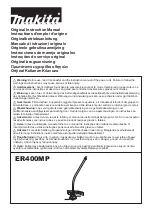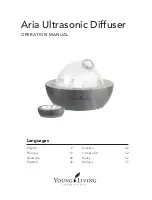
User Manual - PolyGard
®
2 / µGard
®
2
Sensors for Toxic Gases
Page 4
PolyGard
/ µGard
®
are registered trademarks of MSR
Made in Germany
GA_SC2_MC2_Tox_D_0820
Phone +49 8531 9004-0
Fax: +49 8531 9004-54
Specification subject to change without notice
MSR-Electronic GmbH, Buergermeister-Schoenbauer-Str. 13, D 94060 Pocking
www.msr-electronic.de
2
Installation
Electronics can be destroyed by electrostatic discharge (ESD). Therefore the installation work
should be done only by persons connected to ground, e. g. by standing on a conductive floor or
by taking appropriate grounding measures (acc. to DIN EN 100015).
2.1
Mounting Instructions
See description of the SB2, MSC2, MSB2 and WSB2 devices.
When choosing the mounting site please pay attention to the following:
•
The mounting height depends on the relative density of the gas type to be monitored.
Gas type
MSR-Code
Relative density
(air = 1)
Recommended mounting height
(distance to floor / ceiling)
Ammonia
E1125
0.60
Ceiling (0.3 m)
Chlorine
E1193
2.48
Floor (0.2
–
0.3 m)
Hydrogen chloride
E1186
1.27
Floor (0.2
–
0.3 m)
Hydrogen cyanide
E1183
0.93
Ceiling (0.3 m)
Ethylene oxide
E1199
1.56
Floor (0.2
–
0.3 m)
Ethylene
E1189
0.97
1.5
–
1.8 m
Formaldehyde
E1185
1.04
1.5
–
1.8 m
Carbon monoxide
E1110
0.97
1.5
–
1.8 m
Ozone
E1190
1.66
Floor (0.3 m)
Sulphur dioxide
E1196
2.73
Floor (0.2
–
0.3 m)
Hydrogen sulphide
E1197
1.19
Floor (0.2
–
0.3 m)
Nitrogen dioxide
E1130
2.80
0.5
–
1.8 m
Oxygen
E1195
1.11
1.5
–
1.8 m
Table Mounting Heights
The sensor must be installed at the correct height depending on the relative gas density (d). Normal rule is:
d < 0.95: Mount on the ceiling
0.95 < d < 1.05: Mount at a height of 1.5
–
1.8 m above floor
d > 1.05: Mount at a height of 0.3 m above floor
Exception NO
2
: Mounting height for NO
2
sensors: 0.5 to 1.8 m above floor!
•
Choose mounting location of the sensor according to the local regulations.
•
Consider ventilation conditions! Do not mount the sensor near the airflow (air passages, suction
holes etc.).
•
Mount the sensor at a location with minimum vibration and minimum variation in temperature
(avoid direct sunlight).
•
Avoid locations where water, oil etc. may influence proper operation and where mechanical damage
might be possible.
•
Provide adequate space around the sensor for maintenance and calibration work.

































